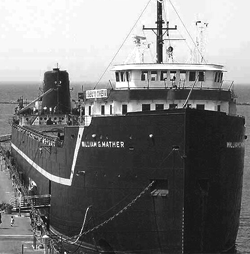The Steamship William G. Mather

Photo by Bernie Thomas, 2006.
The Steamship William G. Mather was built in 1925 by the Great Lakes Engineering Works in River Rouge, Michigan, as the flagship for the Cleveland-Cliffs Iron Company. At 618 feet long and with a capacity of 14,000 long tons, she was among the largest and most advanced Great Lakes freighters of her era, transporting iron ore, coal, stone, and grain across the region. The Mather was notable for pioneering engineering innovations, including being one of the first commercial Great Lakes vessels equipped with radar in 1946 and, in 1964, becoming the first American vessel to feature an automated boiler system. During World War II, she famously led a convoy through ice-choked waters to deliver steel to Duluth, Minnesota, setting a record for the earliest arrival in a northern port.
Representing the evolution of mechanical engineering innovation, the Mather was launched as a state-of-the-art ship for her time, and later served as a prototype, incorporating the latest advancements in technology, including a single oil-fired boiler, steam turbine propulsion, automatic power plant control, as well as a dual propeller bow-thruster. These enhancements allowed Great Lakes shipping to remain efficient, productive and competitive with other modes of transportation - which helped local iron ore sources maintain an economical edge over foreign suppliers.
After decades of service, the Mather was retired in 1980 and later donated to the Great Lakes Historical Society for preservation. Extensive volunteer-led restoration efforts transformed her into a floating maritime museum, which opened in Cleveland in 1991. Today, the William G. Mather is permanently berthed at Dock 32, adjacent to the Great Lakes Science Center, serving as a museum and a testament to the region’s industrial and maritime heritage.
Essential Reading about the William G. Mather
- Historical Photographs of Steamships from the Cleveland Press Collection
- Articles:
- The American Society of Mechanical Engineers Landmark Description Technical and historical significance
- The Steamship William G. Mather: National Historic Mechanical Engineering Landmark (PDF) - 1995 Landmark Description from the American Society of Mechanical Engineers' History and Heritage Program. Describes technical and historical significance.
- Steamship William G. Mather Museum from the Encyclopedia of Cleveland History
- Detailed Service History from "Museum Ships"
- The Steamship William G. Mather: Workhorse of the Great Lakes, historic monument - 2021 article from Freshwater Cleveland
- The William G. Mather: Saving Great Lakes Maritime History - from the National Museum of the Great Lakes, Great Lakes Historical Society
- Print Collections at the Michael Schwartz Library
-
The Steamer William G. Mather Collection at Cleveland State University’s Michael Schwartz Library is a comprehensive archival resource documenting the history and operation of the steamship William G. Mather, which served as the flagship for the Cleveland-Cliffs Iron Company after its launch in 1925. The collection includes:
- Ship logs (1961–1980)
- Chief Engineer smooth logs (1977–1980)
- U.S. Coast Guard Certificates of Inspection (1953–1982)
- Labor arbitration and union files (1930s–1970s)
- Personnel records, including employee cards with details on nationality, injury and sickness reports
- Sample forms, vessel accident reports, mechanical details, operational records, reports, charts, payroll/financial journals, and published reports
- Photographs and slides documenting the vessel and its crew
- External Links:
- Steamship William G. Mather Exhibit - Great Lakes Science Center
- National Museum of the Great Lakes, Toledo, Ohio
- Great Lakes Historical Society



